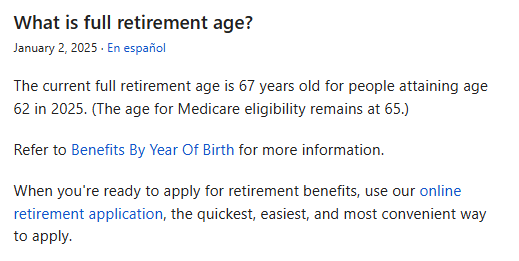Social Security Raises the Bar: If you’ve always pictured retiring at 65, kicking back, and collecting full Social Security checks—think again. As of January 1, 2026, the full retirement age (FRA) will officially shift to 67 for everyone born in 1960 or later. That’s right—retiring at 65 will no longer get you 100% of your Social Security benefits. This shift marks a major milestone in retirement planning in America. While this change has been gradually phasing in since the 1980s, 2026 finalizes it. Going forward, age 67 will be the baseline for collecting unreduced Social Security benefits. For millions of Americans, this means working longer, saving smarter, and adjusting expectations.
Social Security Raises the Bar
Starting in 2026, age 67 becomes the official full retirement age for millions of Americans. It’s the end of an era—but not the end of your retirement dreams. With the right knowledge, planning, and tools, you can navigate this change wisely and still build a secure, comfortable retirement. Whether you’re years from retirement or just starting your first job, it’s never too early—or too late—to plan. Understand how this shift impacts you, explore your options, and take proactive steps to retire on your own terms.

| Topic | Details |
|---|---|
| Effective Date | January 1, 2026 |
| New Full Retirement Age | 67 (for those born in 1960 or later) |
| Early Retirement Age | Still available at 62—but with reduced benefits |
| Maximum Benefits Age | Age 70 (with approximately 8% increase per year past FRA) |
| Reason for Change | Increase life expectancy, financial sustainability of Social Security |
| Who’s Affected | Over 70 million Americans, especially Gen X, Millennials, and Gen Z |
| Official Resource | ssa.gov/retirement |
A Quick History of Full Retirement Age
When Social Security began in 1935, the retirement age was set at 65. Back then, the average life expectancy was around 61. That means many people didn’t live long enough to even collect benefits.
But today, Americans are living well into their late 70s and early 80s. According to the CDC, life expectancy is now around 76.4 years for men and 81.2 years for women. This has stretched Social Security far beyond its original limits.
To address this, the 1983 Social Security Amendments introduced a slow phase-in of a higher full retirement age. It started with people born in 1938, increasing FRA by two months every birth year. In 2026, the last increase takes effect—raising the FRA to 67 for anyone born in 1960 or later.
How the FRA Change Affects Your Social Security Benefits?
Understanding how retirement age affects your benefits is crucial. Your Primary Insurance Amount (PIA) is calculated based on your 35 highest-earning years, and it’s reduced or increased depending on when you claim benefits.

Benefit Comparison by Age
| Claiming Age | % of Full Benefit | Monthly Benefit (if FRA = $2,000) |
|---|---|---|
| 62 | ~70% | $1,400 |
| 65 | ~86.7% | $1,734 |
| 67 | 100% | $2,000 |
| 70 | ~124% | $2,480 |
If you retire early at 62, you get about 70% of your benefit. Retiring at 65 (the old standard) gives you around 86.7%. And if you wait until 70, you get about 24% more than your full benefit.
This means that choosing when you retire can result in hundreds of dollars per month in difference—or tens of thousands over your lifetime.
Who Is Affected by the Social Security Raises the Bar Change?
Anyone born in 1960 or later is directly impacted. That includes:
- Generation X (currently aged 45–64)
- Millennials (ages 28–44)
- Gen Z (just entering the workforce)
This shift doesn’t just impact retirement—it has implications for financial planning, career trajectories, health coverage, and even housing decisions.
Let’s look at some real-life scenarios.
Case Study 1: Maria, Age 64
Maria was born in 1962 and plans to retire in 2026 at age 64. Under the new FRA rules, she won’t be eligible for full benefits until 67. If she files early, she’ll lock in permanently reduced benefits, which may be okay for her lifestyle—but it limits long-term financial flexibility.
Case Study 2: David, Age 61
David earns $75,000 per year and plans to work until 70. By delaying benefits past FRA, he will increase his monthly payout by 24%, giving him a higher base for annual cost-of-living increases. This strategy is ideal for those with good health, low debt, and a longer life expectancy.

Why Is the Retirement Age Increasing?
The short answer: Social Security is running out of money.
Without changes, the Social Security Trust Fund is expected to be depleted by 2034, according to the 2024 Trustees Report. After that, benefits may need to be cut by about 20% unless Congress acts.
Raising the retirement age spreads benefits over fewer years per person, easing strain on the system. It’s one way to maintain solvency without increasing payroll taxes or slashing benefits outright.
How Does This Affect Different Types of Workers?
Blue-Collar Workers
Workers in physically demanding jobs—like construction, farming, or factory work—may find it hard to keep going until 67. They may be forced to retire early, even if it means reduced benefits.
White-Collar Professionals
Professionals and knowledge workers have more flexibility to work longer and may benefit from delayed credits. Strategic planning can help them maximize their payouts.
Self-Employed Individuals
Self-employed folks often have inconsistent income and are solely responsible for funding their own retirement. They need to take extra steps to ensure they’re contributing enough to qualify for solid benefits.
Women and Minorities
Because of historical wage gaps and caregiving responsibilities, women and minorities often have fewer earning years and lower average salaries, which affects benefit calculations. They must be proactive about maximizing their benefits through strategies like delayed retirement and spousal benefits.
Inflation, COLA, and Your Benefits
Each year, the Social Security Administration applies a Cost-of-Living Adjustment (COLA) to help benefits keep pace with inflation.
- 2022 COLA: 5.9%
- 2023 COLA: 8.7%
- 2024 COLA: 3.2%
- 2025 forecast: Between 2.0% and 2.5%
Remember, COLA is applied to your monthly benefit. The higher your base benefit, the more dollars you’ll gain from COLA increases.
For instance, a 3% COLA applied to $2,000 is $60 extra per month. But if you claimed early and locked in $1,400, your COLA would only be $42.
What You Should Do As Social Security Raises the Bar: Step-by-Step Guide
Planning your retirement isn’t just about age—it’s about strategy.
Step 1: Know Your Numbers
- Open a My Social Security account at ssa.gov/myaccount
- Check your estimated benefits
- Understand your earnings record
Step 2: Consider All Sources of Income
- Pensions
- 401(k), 403(b), or IRA accounts
- Rental properties or side hustles
- Spouse’s income or benefits
Step 3: Use Retirement Calculators
- SSA’s Retirement Estimator
- AARP Retirement Calculator
- Financial advisor tools (like Fidelity, Vanguard, or Charles Schwab)
Step 4: Talk to a Financial Advisor
Don’t wait until your last year of work. By age 50, you should start having serious conversations about retirement timelines, taxes, and income planning.
Social Security Just Raised Full Retirement Age—And It Might Not Stop There
3 Crucial Social Security Updates in 2025 That Could Redefine Your Retirement Strategy
Big Changes to Social Security in 2025: Who Can Still Claim Full Retirement Benefits?











